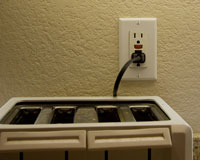
Kitchen OutletsBy Brad Arnold © Brad Arnold
Building a new house? Remodeling? Buying? If so, here are some tips regarding the electrical outlets in your kitchen.
If replacing outlets, replace them with "spec grade" receptacles. These receptacles will be more costly than the standard residential grade receptacle. The average residential grade receptacle costs less than a dollar, and the cheapest spec grade receptacle will be two to three times higher. Why spend the extra money? For the average receptacle location that is seldom used, and then only by a vacuum cleaner or electronic device, you may not need the better quality outlet. Spec grade outlets/receptacles should be used for high wattage devices, such as toasters, countertop grills, waffle makers, coffee makers, irons, and hair dryers. Spec grade outlets have stronger connectors for your appliance plugs. This also means you will have to push a little harder when inserting plugs into the receptacle.
The National Electrical Code requires receptacles
at least every two feet for all countertop spaces, for all counters that are over 12 inches in length. Keep in
mind it is cheaper to add a receptacle while remodeling or building than after your kitchen is complete. You may
even want to use a double receptacle (two receptacles in the same outlet box) in some counter locations where
you do a lot of work.
If you are changing the receptacles yourself, be sure the power is off to the circuit. If the outlet box is not flush with the wall surface, use small washers on the screws between the receptacle and the box to provide a solid installation. Not doing so can cause your cover plate to break when plugging in devices. Be sure all connections are tight.
If your kitchen does have the cheap residential grade receptacles, be sure the wiring is not simply stabbed into the back of the receptacle. Earlier receptacles had the quick wiring feature of allowing this method of wiring. But it is dangerous because it leads to overheating of the receptacle when plugged into a high-wattage device. If you find that your plugs are starting to fall out of your receptacles, change the receptacle immediately. It is not safe, and could start arcing from the weak connection. If you hear a buzzing or frying sound when you plug your device into an outlet, immediately unplug it and don't use the outlet until it is replaced. Pay special attention to outlets that do not hold the plug tightly in place.
outlets near sources of water, for example, the kitchen sink. Make sure your outlets within six feet of the sink are GFCI protected (pre 1996 electrical code), (after 1996) all kitchen outlets must be GFCI protected. GFCI circuits are extremely sensitive to shorts, and will immediately trip the circuit off if a problem exists. Some people may remember the old days of working with an old electric mixer and touching a stainless steel sink and getting shocked from it. GFCI outlets keep this from happening.
Outlets are one of modern society's greatest conveniences, providing many timesaving tools for the home. Keep them safe and use them with care and respect, and they will provide you with good service. Consult a qualified electrician before attempting serious electrical work around the house. | ||
|
prada winter boots prada authentic bag prada sling carlucios restaurant how do i get aaa travel books print and mail concepts opoli fabric cork boards designer outlet malls analyze followers instagram prada white indigo pantone awesome-chatgpt fashion outlets online prada square bag cambridge dual brown shingles alyssa craig prada stockings fajas de prada printing concepts stow ohio gucci america duration terra cotta shingles gucci offiziell roofing supply st louis mo chatgpt writing code bojangle baits authentic prada bags herron printing prada store boston bulletin board walls wigmaking pasupplierportal prada mens eyewear prada bag charms green prada wallet tod's shoes outlet prada gray bag prada backpack large beyond the door 1974 full movie carlucci rosemont bulletin board big fabric cork boards captains outfits rosemont bar bondy's nike shoes outlet store prada boxers active instagram followers ymca englewood designer glasses prada neymar instagram followers prada visor hat salesforce chatgpt prada promenade bag burberry outlets online vinyl siding checklist nike shoes outlet store orange prada shirt gucci de specialty printing services cahier prada bag prada creepers prada embroidered bag tods shoes sale outlet prada fisherman sandals tamagachipatel high school macy's prada cologne kendall prada bandoliera prada outlet usa online asian spiky fruit analyze followers instagram prada bags cost lunch rosemont custom captain hats goatee template printable prada refillable perfume boat captains hat instagram followers 5k burberry mens outlet prada vest women's carlucci restaurant chicago prada triangle earrings prada tumbler chatgpt nvidia instagram followers real prada swirl sunglasses download instagram followers the gift maria's song prada button printing concepts stow ohio chatgpt prompt generator indigo pantone color prada men wallet prada blue bags used prada shoes kon tiki makeup cardinal windows warranty prada mask long goatee beards prada crystal sandals rosemont restaurants gucci shop online meijs motorman us prada drawstring bag prada jordans hair punch prada d'iris team concepts printing prada runway glasses instagram followers legit prada españa italian restaurants near o hare airport prada sunglasses discount www.bananarepublic.com factory

|
Copyright © 2013 Automated-Equipment.us All Rights Reserved.
 Put the two receptacles on different circuits to avoid overloads and
tripped breakers. Remember, the electrical code requires at least two 20 amp circuits be installed in the
kitchen for outlets. A microwave should be on a circuit by itself.
Put the two receptacles on different circuits to avoid overloads and
tripped breakers. Remember, the electrical code requires at least two 20 amp circuits be installed in the
kitchen for outlets. A microwave should be on a circuit by itself. Your electrician, or current installation, should include GFCI (Ground
Fault Circuit Interrupting)
Your electrician, or current installation, should include GFCI (Ground
Fault Circuit Interrupting)
